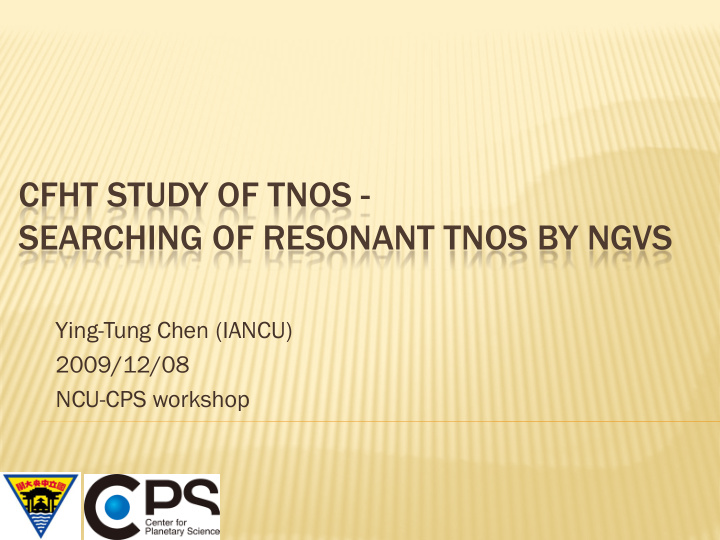



CFHT STUDY OF TNOS - SEARCHING OF RESONANT TNOS BY NGVS Ying-Tung Chen (IANCU) 2009/12/08 NCU-CPS workshop
WHAT’S NGVS The Next Generation Virgo Cluster Survey (NGVS) is an approved Large Programme for the Canada French Hawaii Telescope (CFHT). The NGVS will use 771 hours of CFHT time (approx. 140 nights), spread equally over the 2009A-2012A semesters, To image the Virgo Cluster - the dominant mass concentration in the local universe and the largest collection of galaxies within ≈35 Mpc - from its core to virial radius, in five filters (u,g,r,i,z), to unprecedented depths. etc
THE SURVEY Depth (points source, S/N=10) u* = 25.9 AB mag g’ = 25.7 AB mag r’ = 25.2 AB mag i’ = 24.9 AB mag z’ = 24.6 AB mag
SCIENCE ON NGVS NGVS PI: Laura Ferrarese, co- PI of KBOs: JJ Kavelaars (NRC Herzberg Institute of Astrophysics, Canada) Virgo science The faint-end shape of the luminosity function The characterization of galaxy scaling relations Connection between stellar nuclei and supermassive BHs Connection between cluster, galaxies and the ISM Star formation and chemical enrichment Background science Galactic extinction background structures Foreground science the shape and symmetry of the stellar halo KBOs and planetary formation
RESONANT TNOS As TNOs were discovered, a substantial proportion were found to be in resonances with Neptune, far from being a random distribution. It is now generally believed that these objects have been collected from wider distances by sweeping resonances during the outward orbital migration of Neptune. (Malhotra, 1995).
TWOTINOS The spatial distribution of Kuiper Belt objects (KBOs) in 2:1 exterior resonance with Neptune constrains the planetary migration history. Numerical simulations demonstrate that fast planetary migration (time scale < 10 7 yr ) would generate a larger population of KBOs trailing rather than leading Neptune in orbital longitude. (Murray- Clay & Chiang 2005). 10 7 yrs 10 6 yrs
THE MAG DISTRIBUTION OF TNOS Fraser and Kavelaars (2009)
RESULTS OF NGVS KBOS Linking system : Pan- STARRS MOPS (Moving Object Processing System) 24 KBOs found on NGVS 2009A. Predictions of KBOs positions for each 14 days 2009 2010 CFHT 2010A Follow-up 2010B Follow -up NGVS 2009A NGVS 2010A
FUTURE WORKS CFHT 2010A proposal is awarded 10.5 hrs of observing time. Follow- up of 2009A NGVS KBOs by CFHT , Gemini, or other telescope. More KBOs found and identified by NGVS on CFHT 2010A ~ 2012A. Debias of survey results, building Model to fit distribution of twotinos KBO.
Recommend
More recommend